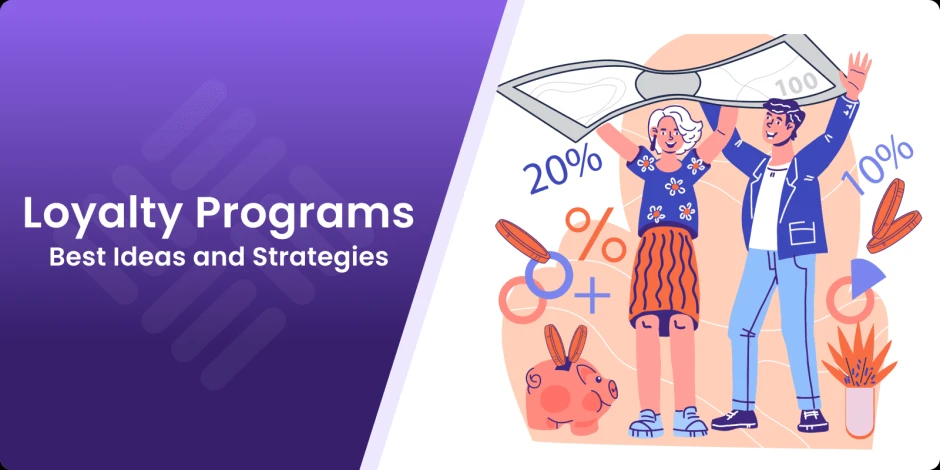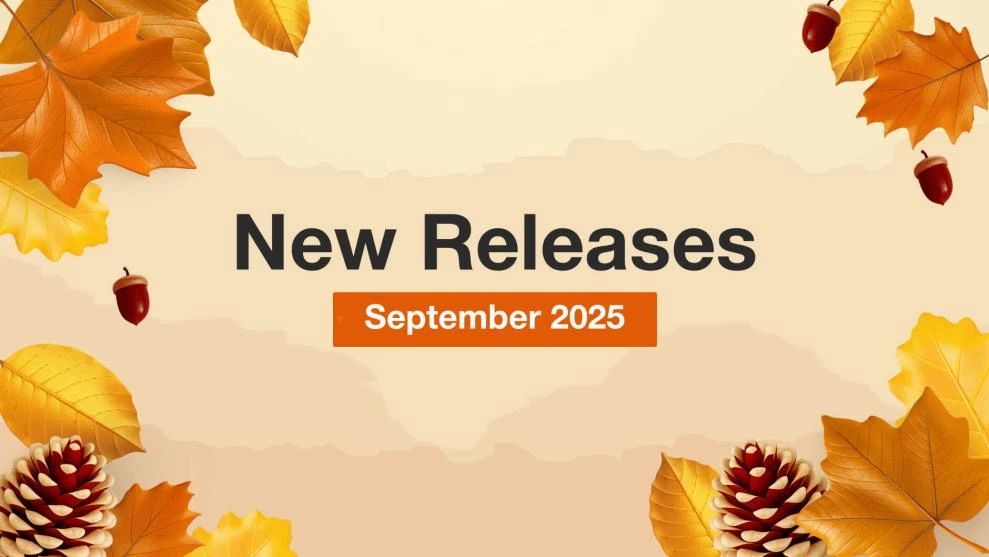Best Ecommerce Loyalty Programs: Top Picks for Online Stores
-
 Eugen Barilyuk
Eugen Barilyuk
- Online Marketing
- 12 min read
You may already know based on your own merchant’s experience that it's no longer sufficient to rely solely on product quality and pricing to maintain the success of a business. Fostering customer loyalty has become a cornerstone of success for retailers who want to ensure a steady stream of revenue. If you're on a quest to elevate both sales figures and customer loyalty in the online retail sphere, it's time to unravel the latest and most effective tactics in ecommerce rewards programs.
Why a store depends on customer loyalty
Customer loyalty is a fundamental inquiry that underpins the very survival and growth of businesses. One can say it is the bedrock upon which successful stores are built. It is noteworthy that nearly three-quarters of companies, or approximately 73% of them, as Gartner reports, place a greater reliance on their existing customer pool rather than allocating resources for the pursuit of novel market expansions.
From a glance a group of loyal customers can be mistakenly considered simply as repeat buyers. However, the core of the loyalty is about fostering a dedicated and emotionally connected customer base.
When people feel loyal to a store, they are more likely to become its advocates, spreading positive word-of-mouth and influencing their friends, relatives, colleagues and others in their social circle. This organic promotion is a powerful marketing tool that can be even more effective than traditional advertising.
Moreover, loyal customers not only tend to spend more than one-time or new shoppers. They are willing to invest in a brand they feel connected to even if it costs them more.
It is striking to note that 59% of consumers, as reported by Edelman, express a heightened inclination to acquire newly introduced offerings from a brand even in cases where these offerings are not competitively priced when compared to rival options.
Such behavior towards store's products or services can be explained by their beliefs, because they trust their favorite brand. This trust is a result of consistently positive experiences, quality shopping process, and excellent customer service. In essence, loyal customers become an essential source of revenue for businesses.
Customer loyalty also provides a buffer against market fluctuations and competition. In times of economic uncertainty, loyal customers are more likely to stick with a brand they trust, providing a steady stream of income. A store with a strong and loyal base of customers is better equipped to fend off competitors and maintain its market share.
With the proliferation of online shopping, consumers have an abundance of choices at their fingertips. To stand out in this digital landscape, stores must offer not only great products but also exceptional experiences. Loyal customers appreciate the convenience, personalized recommendations, and tailored offers that merchants can provide.
Technology has enabled stores to offer what customers expect to build their trust in a brand. There are tools to gather vast amounts of data on people’s preferences and behaviors. This data can be leveraged to create targeted marketing campaigns and loyalty programs that further strengthen merchant-customer bonds.
Customer loyalty isn't just a nice-to-have thing for an online merchant. It is a strategic imperative that influences growth, revenue, and resilience. Maintaining customer loyalty should be at the forefront of every store's business strategy.
Loyalty reward programs are the major trend
One of the most significant trends that have taken center stage in the task of building mutually beneficial relationships with shoppers is the proliferation of loyalty programs in ecommerce. These incentives have transformed the way consumers interact with online shopping, and their popularity continues to soar.
A notable portion of consumers express a sense of devotion towards a brand or enterprise. Almost 74% of them say they have a sense of commitment to at least one brand, according to the Zendesk report. About 52% of shoppers are willing to put additional efforts when they want to purchase something that their favorite brand offers.
What drives the loyalty rewards trend
But what exactly is driving this trend, and why have ecommerce loyalty rewards become such a major force in the world of e-commerce? The rise of this trend is clearly visible in the amount of money merchants are willing to invest.
As of 2023, the global management investments in the market of loyalty programs and ecommerce loyalty software boasted a figure of $6.47 billion. This number is almost a billion higher ($5.29 billion) than in the previous 2022 year. The investments will continue to increase in the years to come, and are forecasted to reach an impressive $28.65 billion by 2030, according to Fortune Business Insights.
To begin with, loyalty reward programs offer a multitude of benefits for both businesses and customers alike. For businesses, these programs represent a powerful tool for increasing customer retention and boosting sales.
By offering incentives and rewarding their clients for various types of activities, companies can entice people to return to them when people are ready to make another purchase.
Value of reward from shoppers’ perspective
From a customer perspective, loyalty reward programs create a sense of value and recognition. Zendesk report also states that people become loyal to a brand due to a set of multiple factors:
- Price 62%
- Customer service 57%
- Product/service offerings 54%
- Convenience of purchase or use 45%
- Brand reputation 34%
- Personalization and promotions 27%
Shoppers are not just making transactions; they are investing in a relationship with a brand and they want to know that their loyalty is acknowledged. The recognition of customer’s loyalty can be highlighted with earning points, receiving exclusive discounts, or gaining early access to sales.
These perks make customers feel special and appreciated and they build an emotional connection with a store. When such a connection is established, people tend to spend 27% more, according to the Bond report.
Alongside the growing focus on shoppers’ sense of connection, loyalty programs a data goldmines for highlights on clientele retention. They allow companies to collect valuable insights into behavior and preferences of their participants.
This data can then be harnessed to create personalized marketing campaigns, recommend products tailored to individual tastes, and refine the overall experience the store can offer to its clientele.
Ecommerce loyalty program ideas and strategies
With a multitude of options available at their fingertips, consumers need a compelling reason to choose one online store over another. This is where e commerce loyalty program comes into play, offering innovative and strategic ways to capture and retain the attention of a person that has a potential to become a consistent client.
Best ecommerce loyalty programs come in a myriad of shapes and sizes, each with its unique approach to winning the hearts and minds of people.
Loyalty programs suitable both for online and offline sales points
Reward with points
This strategy grants clients some amount of virtual points for every dollar spent or specific action, like purchasing two items instead of one.
This loyalty program concept can be named as a most simple to implement. Points-based loyalty programs are grounded in the psychology of rewards and incentives.
Customers, inherently drawn to the idea of receiving something extra, are motivated to make repeat purchases to earn more points. And due to its proven effectiveness it is widely used even by industry giants, such as Amazon, Mastercard, McDonald's, Best Buy, and dozens of others.
Tiered rewards
One effective approach that has gained prominence is the tiered loyalty program. This method proposes rewards based on the level of engagement and spending of a person. The higher spending, the higher tier is awarded.
As clients ascend the ladder of tiers, they unlock exclusive perks such as early access to sales, personalized product offerings, and dedicated customer support. This tiered structure not only incentivizes continued shopping but also fosters a sense of achievement and belonging.
Convert getting a reward into a game
Another transformative strategy in ecommerce loyalty programs is gamification. By infusing elements of gaming, such as challenges, badges, and points, businesses make the experience more enjoyable. Gamification injects an element of fun into the shopping journey, making it more memorable and engaging.
This type of ecommerce loyalty rewards program motivates customers to complete tasks to earn bonuses. A merchant may even gamify his loyalty incentive in a way that makes shoppers compete with others.
Paid access to loyalty program
If clients can get increased amount of rewards by paying for the exclusive access to loyalty program, a lot of them will do this. They can join as by making a direct participant fee, or by spending significantly more on purchases.
McKinsey reports that customers who put additional efforts in the form of investing their own money to join the loyalty program tend to spend up to 60% more when compared to the regular shopper. This figure is twice as high when compared to level of spending of a member of more easily accessible loyalty program.
Engage people in loyalty program before they become clients
Typically, loyalty incentives were designed to reward existing clientele, encouraging them to keep coming back. But what if businesses could harness the power of such programs even before someone becomes an actual client?
Engage people in a loyalty program before they make their first purchase. This forward-thinking approach creates an early bond with potential customers, helping establish trust and improving the chances of converting them into paying clients.
A loyalty program e commerce business can offer ahead of the shoppers’ first purchase involves offering them exclusive perks and rewards as a gesture of goodwill.
A simplest example of such loyalty offering is a discount for a first-time shopper for registering his account. By delivering their offering from the get-go, businesses demonstrate their commitment to potential customers, setting a strong foundation for future transactions.
Put your chips on referrals
Incentivizing people to become advocates for your brand is a primary goal for any merchant since each of such advocates has a potential to become a powerful sales channel.
The referral-based loyalty program encourages people to get rewards for promoting a brand they like to their friends, family, or colleagues. This not only drives new business but also strengthens existing customer relationships.
The concept of referral-based loyalty programs capitalizes on the power of personal recommendations. People tend to trust the opinions and experiences of those they know, making referrals the most credible form of advertising. A substantial 84% of individuals trust recommendations made by individuals within their social circles, as reported by Nielsen.
When existing clientele of your business become advocates for your brand, they not only bring in new business but also strengthen their own loyalty to your company.
One of the remarkable advantages of referral-based loyalty programs is their ability to create a sense of community among the customer base. Clients who actively refer others to a brand feel a deeper connection and engagement with the latter. They become ambassadors who champion your products or services, helping to build a loyal and passionate customer community.
Build loyalty through shoppers’ values
The traditional loyalty program model has largely revolved around offering discounts, rewards, or exclusive privileges for the customers. However, it is possible to stand out among competitors by connecting with clientele on deeper level of their life values.
One such innovative loyalty incentive that has gained considerable attention is the value-based loyalty program. It does not include direct benefits for the shopper; instead it involves donating to charity or welfare programs.
By allocating a portion of each sale for charity or welfare, businesses can attract and retain customers who appreciate their commitment to making a positive impact on society.
The value-based loyalty incentive is one of the best loyalty programs ecommerce can incorporate as it can have a ripple effect on a company's reputation and new customer acquisition efforts.
Clientele who participate in such programs often become enthusiastic advocates, spreading the word about the brand's commitment to social causes. This word-of-mouth marketing can attract new shoppers who share similar values, leading to organic growth in the customer base.
Birthday and anniversary rewards
Show your clientele that you are also loyal to them as they are loyal to you by providing bonuses for special and personal occasions.
Celebrate important milestones of your customers who go together with your business by sending them personalized birthday and anniversary offers. These may be discount codes, special gifts, exclusive services, etc.
Loyalty programs exclusive to offline sales points
Geolocation loyalty incentives
Offer rewards to customers who purchase at specific physical locations. This can help to increase the number of visitors for stores that need it, and shoppers can be rewarded for their efforts.
A merchant can build such geolocation incentive on his own or join a Shopkick. it is a shopping reward app with an option of rewarding users for buying in a specific shop.
Punch card rewards
Attract people to visit a store more often by issuing them a physical card. Each time purchase is made in a physical store the card is stamped or punched. When a certain number of punches has been reached, customers earn a reward or discount.
In-store contests
Make shopping fun by organizing a competitive shopping process. Give rewards for challenges that encourage customers to interact with products or store layout.
Local partnerships
Collaborate with nearby businesses to create a co-branded loyalty program. A person can make a purchase in one physical location, but to redeem the reward he should visit another physical location. And vice versa. This will encourage customers to shop at both locations.
Loyalty programs exclusive for online sales points
Rewards for purchases via a store’s app
You can make online shopping more interactive if it happens via your mobile app. When a shopper uses store’s mobile app he can receive immediate notifications on fresh marketing proposals and he can get a better experience overall.
Stimulate usage of your app by providing app-exclusive discounts, features, and loyalty rewards for online customers.
Abandoned cart rewards
A lot of shoppers simply leave during the shopping process, making an abandoned cart. Encourage customers to finish their orders by giving them bonuses for successfully paid orders.
Add tiers to make the thin loyalty program even more engaging. For example, provide a level one reward for a client who makes 10 purchases in a row without an abandoned cart. Give level two reward for a person with a score of 20 purchases without an abandoned cart, and so forth.
Summary
The success of a retail business can be tightly connected to the loyalty of its audience. A dominant trend in this regard is the rise of loyalty reward programs, which offer mutually beneficial incentives to both businesses and customers alike.
Engaging people through loyalty programs can start even before they convert into actual clients. Such incentives then continue engaging shoppers during all the time their relationships with the merchant exist.
To make a deeper connection with clients a merchant can use time-proven basic concepts, or he can invent his own unique mix. Use a list of ideas provided above to present clients with the best loyalty program both for you and your clientele.




